Where Is Berthe Morisot Display Where Is Berthe Morisot Display of Art
| Berthe Morisot | |
|---|---|
 Berthe Morisot | |
| Born | Berthe Marie Pauline Morisot (1841-01-fourteen)January 14, 1841 Bourges, Cher, French republic |
| Died | March 2, 1895(1895-03-02) (aged 54) Paris, French republic |
| Resting place | Cimetière de Passy |
| Nationality | French |
| Known for | Painting |
| Notable piece of work |
|
| Movement | Impressionism |
| Spouse(s) | Eugène Manet (m. 1874; died 1892) |
Berthe Marie Pauline Morisot (French: [bɛʁt mɔʁizo]; January 14, 1841 – March 2, 1895) was a French painter and a fellow member of the circumvolve of painters in Paris who became known equally the Impressionists.
In 1864, Morisot exhibited for the first time in the highly esteemed Salon de Paris. Sponsored past the government and judged by Academicians, the Salon was the official, annual exhibition of the Académie des beaux-arts in Paris. Her work was selected for exhibition in six subsequent Salons[one] until, in 1874, she joined the "rejected" Impressionists in the starting time of their ain exhibitions, which included Paul Cézanne, Edgar Degas, Claude Monet, Camille Pissarro, Pierre-Auguste Renoir and Alfred Sisley. It was held at the studio of the photographer Nadar. Morisot went on to participate in all but 1 of the following 8 impressionist exhibitions, between 1874 and 1886.[two]
Morisot was married to Eugène Manet, the brother of her friend and colleague Édouard Manet.[3]
She was described past art critic Gustave Geffroy in 1894 as one of "les trois grandes dames" (The 3 great ladies) of Impressionism alongside Marie Bracquemond and Mary Cassatt.[4]
Early life [edit]
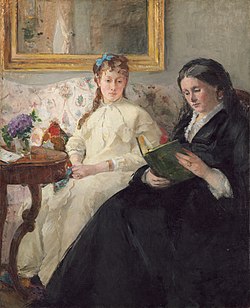
Berthe Morisot, Portrait de Mme Morisot et de sa fille Mme Pontillon ou La lecture (The Mother and Sister of the Artist – Marie-Joséphine & Edma) 1869/70
Morisot was born Jan 14, 1841,[5] in Bourges, France, into an affluent conservative family unit. Her father, Edmé Tiburce Morisot, was the prefect (senior ambassador) of the department of Cher. He also studied compages at École des Beaux Arts.[vi] Her mother, Marie-Joséphine-Cornélie Thomas, was the great-niece of Jean-Honoré Fragonard, i of the most prolific Rococo painters of the ancien régime.[7] She had two older sisters, Yves (1838–1893) and Edma (1839–1921), plus a younger brother, Tiburce, born in 1848. The family moved to Paris in 1852, when Morisot was a child.
It was commonplace for daughters of bourgeois families to receive art education, so Berthe and her sisters Yves and Edma were taught privately by Geoffroy-Alphonse Chocarne and Joseph Guichard. Morisot and her sisters initially started taking lessons so that they could each make a drawing for their father for his altogether.[half dozen] In 1857 Guichard, who ran a school for girls in Rue des Moulins, introduced Berthe and Edma to the Louvre gallery where from 1858 they learned past copying paintings. The Morisots were not but forbidden to work at the museum unchaperoned, only they were also totally barred from formal training.[8] Guichard too introduced them to the works of Gavarni.[9]
As fine art students, Berthe and Edma worked closely together until 1869, when Edma married Adolphe Pontillon, a naval officeholder, moved to Cherbourg, and had less time to pigment. Letters betwixt the sisters show a loving human relationship, underscored by Berthe'due south regret at the distance between them and Edma's withdrawal from painting. Edma wholeheartedly supported Berthe'south connected work and their families always remained shut. Edma wrote "… I am often with you lot in idea, dear Berthe. I'k in your studio and I like to slip away, if just for a quarter of an hour, to exhale that atmosphere that we shared for many years…".[ten] [11] [12]
Her sister Yves married Theodore Gobillard, a taxation inspector, in 1866 and was painted past Edgar Degas equally Mrs Theodore Gobillard (Metropolitan Museum of Fine art, New York Metropolis).[ten] [11] [thirteen]
As a copyist at the Louvre, Morisot met and befriended other artists such as Manet and Monet.[eight] In 1861 she was introduced to Jean-Baptiste-Camille Corot, the pivotal landscape painter of the Barbizon schoolhouse who besides excelled in figure painting. Under Corot's influence she took up the plein air (outdoors) method of working.[14] By 1863 she was studying under Achille Oudinot, another Barbizon painter. In the winter of 1863–64 she studied sculpture nether Aimé Millet, but none of her sculpture is known to survive.[9]
Main periods of Morisot's piece of work [edit]
Training, 1857–1870 [edit]
It is hard to trace the stages of Morisot'south training and to tell the exact influence of her teachers because she was never pleased with her work and she destroyed well-nigh all of the artworks she produced before 1869. Her outset teacher, Geoffroy-Alphonse Chocarne, taught her the basics of cartoon. After several months, Morisot began to accept classes taught by Guichard. During this period, she drew mostly ancient classical figures. When Morisot expressed her interests in plein-air painting, Guichard sent her to follow Corot and Oudinot. Painting outdoors, she used watercolors which are easy to carry. At that time, Morisot also became interested in pastel.[fifteen]
Watercolorist, 1870–1874 [edit]
During this period, Morisot still plant oil painting difficult, and worked by and large in watercolor. Her choice of colors is rather restrained; however, the delicate repetition of hues renders a balanced effect. Due to specific characteristics of watercolors as a medium, Morisot was able to create a translucent temper and feathery touch, which contribute to the freshness in her paintings.[16]
Impressionism, 1875–1885 [edit]
Having become more confident about oil painting, Morisot worked in oil, watercolor and pastel at the same fourth dimension, as Degas did. She painted very chop-chop but did much sketching every bit preparation, so she could paint "a mouth, eyes, and a olfactory organ with a unmarried brushstroke." She made countless studies of her subjects, which were fatigued from her life and so she became quite familiar with them. When it became inconvenient to paint outdoors, the highly finished watercolors done in the preparatory stages immune her to go along painting indoors later.[17]
Turning, 1885–1887 [edit]
After 1885, cartoon began to dominate in Morisot'due south works. Morisot actively experimented with charcoals and color pencils. Her reviving interest in drawing was motivated past her Impressionist friends, who are known for blurring forms. Morisot put her emphasis on the clarification of the grade and lines during this period. In addition, she was influenced by photography and Japonisme. She adopted the mode of placing objects away from the centre of the limerick from Japanese prints of the time.[xviii]
Synthesis, 1887–1895 [edit]
Morisot started to use the technique of squaring and the medium of tracing paper to transcribe her drawing to the canvass exactly. By employing this new method, Morisot was able to create compositions with more complicated interaction between figures. She stressed the composition and the forms while her Impressionist brushstrokes still remained. Her original synthesis of the Impressionist touch with wide strokes and light reflections, and the graphic arroyo featured past clear lines, made her late works distinctive.[19]
Style and technique [edit]
Because she was a female creative person, Morisot'south paintings were often labeled as being full of "feminine charm" by male person critics, for their elegance and lightness. In 1890, Morisot wrote in a notebook about her struggles to be taken seriously as an artist: "I don't think at that place has always been a man who treated a woman as an equal and that's all I would accept asked for, for I know I'k worth every bit much every bit they." Her light brushstrokes ofttimes led to critics using the verb "effleurer" (to affect lightly, brush against) to describe her technique. In her early life, Morisot painted in the open air as other Impressionists to look for truths in observation.[20] Around 1880 she began painting on unprimed canvases—a technique Manet and Eva Gonzalès too experimented with at the time[21]—and her brushwork became looser. In 1888–89, her brushstrokes transitioned from short, rapid strokes to long, sinuous ones that ascertain form.[22] The outer edges of her paintings were often left unfinished, assuasive the canvas to show through and increasing the sense of spontaneity. Afterwards 1885, she worked generally from preliminary drawings earlier get-go her oil paintings.[23] She as well worked in oil paint, watercolors, and pastel simultaneously, and sketched using various drawing media. Morisot's works are virtually always small in calibration.
Morisot creates a sense of space and depth through the use of color. Although her colour palette was somewhat limited, her fellow impressionists regarded her as a "virtuoso colorist".[23] She typically made expansive use of white to create a sense of transparency, whether used as a pure white or mixed with other colors. In her large painting, The Cherry Tree, colors are more vivid but are nonetheless used to emphasize form.[23]
Inspired by Manet's drawings, she kept the use of color to the minimum when constructing a motif. Responding to the experiments conducted by Manet and Edgar Degas, Morisot used barely tinted whites to harmonize the paintings. Like Degas, she played with three media simultaneously in one painting: watercolor, pastel, and oil paints. In the second half of her career, she learned from Renoir by mimicking his motifs.[20] She also shared an interest in keeping a residual between the density of figures and the atmospheric traits of calorie-free with Renoir in her later works.[24]
Subjects [edit]
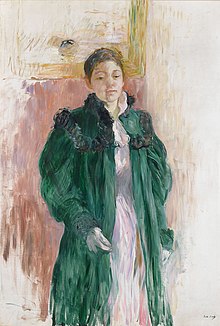
Jeune Fille au Manteau Vert, oil on canvas, c. 1894
Morisot painted what she experienced on a daily basis. Most of her paintings include domestic scenes of family unit, children, ladies, and flowers, depicting what women's life was similar in the late nineteenth century. Instead of portraying the public space and the society, Morisot preferred individual, intimate scenes.[20] It somehow reflects the cultural restrictions of her form and gender at that fourth dimension. Like her fellow Impressionist Mary Cassatt, she focused on domestic life and portraits in which she could employ family unit and personal friends every bit models, including her daughter Julie and sis Edma. The stenographic presentation of her daily life conveys a strong hope to stop the fleeting passage of time.[20] By portraying flowers, she used metaphors to celebrate womanhood.[25] Prior to the 1860s, Morisot painted subjects in line with the Barbizon school before turning to scenes of gimmicky femininity.[26] Paintings like The Cradle (1872), in which she depicted current trends for nursery furniture, reverberate her sensitivity to fashion and advertising, both of which would have been apparent to her female audition. Her works also include landscapes, garden settings, boating scenes, and theme of boredom or ennui.[20] Afterwards in her career Morisot worked with more ambitious themes, such equally nudes.[27] In her late works, she oftentimes referred to the past to think the memory of her earlier life and youth, and her departed companions.[20]
Impressionism [edit]

Morisot'southward first advent in the Salon de Paris came at the historic period of twenty-3 in 1864, with the acceptance of ii landscape paintings. She continued to evidence regularly in the Salon, to more often than not favorable reviews, until 1873, the year before the commencement Impressionist exhibition. She exhibited with the Impressionists from 1874 onwards, only missing the exhibition in 1878 when her daughter was built-in.[28]
Impressionism'southward declared attachment to brilliant color, sensual surface effects, and fleeting sensory perceptions led a number of critics to assert in retrospect that this way, one time primarily the battlefield of insouciant, antagonistic males, was inherently feminine and best suited to women'due south weaker temperaments, bottom intellectual capabilities, and greater sensibility.[29]
During Morisot's 1874 exhibition with the Impressionists, such equally Monet and Manet, Le Figaro critic Albert Wolff noted that the Impressionists consisted of "v or half dozen lunatics of which one is a woman...[whose] feminine grace is maintained amid the outpourings of a delirious listen."[8]
Morisot's mature career began in 1872. She found an audience for her work with Durand-Ruel, the private dealer, who bought twenty-ii paintings. In 1877, she was described by the critic for Le Temps equally the "one existent Impressionist in this group."[30] She chose to exhibit under her full maiden name instead of using a pseudonym or her married name.[31] As her skill and manner improved, many began to rethink their opinion toward Morisot. In the 1880 exhibition, many reviews judged Morisot amongst the best, even including Le Figaro critic Albert Wolff.[32]

Personal life [edit]
Morisot came from an eminent family, the daughter of a authorities official and the great-niece of a famous Rococo artist Jean-Honoré Fragonard.[33] She met her longtime friend and colleague, Édouard Manet, in 1868. By the introduction of Manet, Morisot was married to Édouard's brother, Eugène Manet in 1874. On November 14, 1878, she gave birth to her only child, Julie, who posed ofttimes for her female parent and other Impressionist artists, including Renoir and her uncle Édouard.
Correspondence between Morisot and Édouard Manet shows warm affection, and Manet gave her an easel as a Christmas nowadays. Morisot often posed for Manet and in that location are several portrait painting of Morisot such as Repose (Portrait of Berthe Morisot) and Berthe Morisot with a Boutonniere.[34] Morisot died on March 2, 1895, in Paris, of pneumonia contracted while attending to her daughter Julie's similar illness, thus making Julie an orphan at the age of 16. She was interred in the Cimetière de Passy.[35]
Works [edit]

Selection of works [edit]
- This list is incomplete, you tin help by expanding information technology with certified entries.
This limited selection is based in part on the book Berthe Morisot by Charles F. Stuckey, William P. Scott and Susan G. Lindsay, which is in plow drawn from the 1961 catalogue past Marie-Louise Bataille, Rouaart Denis and Georges Wildenstein. There are variations between the dates of execution, commencement showing and purchase. Titles may vary between sources.
1864–1874 [edit]
- Étude, 1864, oil on canvas, threescore.3 × 73 cm, private collection[36]
- Chaumière en Normandie, 1865, oil on canvas, 46 × 55 cm, private collection[37]
- La Seine en aval du pont d'Iéna, 1866, oil on canvas, 51 × 73 cm, private collection[38]
- La Rivière de Pont Aven à Roz-Bras, 1867, oil on canvas, 55 × 73 cm, private collection – Chicago[39]
- Bateaux à l'aurore, 1869, pastel on newspaper, 19.7 × 26.7 cm, individual drove[40]
- Jeune fille à sa fenêtre, 1869, oil on canvas, 36.8 × 45.four cm, private collection
- Madame Morisot et sa fille Madame Pontillon (La Lecture), 1869–1870, oil on canvas, 101 × 81.8 cm, National Gallery of Art, Washington, D.C.[41]
- Le Port de Cherbourg, 1871, crayon and watercolour on paper, 15.six × 20.3 cm, private collection of Paul Mellon, Upperville, Virginia[42]
- Le Port de Cherbourg, 1871, oil on canvas, 41.nine × 55.9 cm, private drove of Paul Mellon, Upperville, Virginia[43]
- Vue de paris de hauteurs du Trocadéro, 1871, oil on canvass, 46.1 × 81.five cm, Santa Barbara Museum of Art, California[44]
- Femme et enfant au balcon, 1871–72, watercolor, twenty.half dozen × 17.iii cm, Art Plant of Chicago[45] [46] [47]
- Intérieur, 1871, oil on canvas, 60 × 73 cm, private collection[48]
- Portrait de Madame Pontillon, 1871, pastel on newspaper, 85.v × 65.8 cm, Louvre – drawings chiffonier[49] souvenir of Madame Edma Pontillon to the Louvre in 1921, in the collection of the Musée d'Orsay[l]
- L'Entrée du port, 1871,[Note 1] watercolour on paper, 24.ix × 15.1 cm, Musée Léon-Alègre, Bagnols-sur-Cèze – drawings cabinet[51]
- Madame Pontillon et sa fille Jeanne sur un canapé, 1871, watercolour on paper, 25.one × 25.9 cm, National Gallery of Art, Washington[52]
- Jeune fille sur un banc (Edma Pontillon), 1872, oil on canvas, 33 × 41 cm,[53]
- Enshroud-cache, 1872, oil on canvas, 33 × 41 cm, Private collection[54]
- Le Berceau, 1872, oil on sheet, 56 × 46 cm Musée d'Orsay, Paris
- La Lecture (Edma lisant), likewise titled 50'Ombrelle verte, 1873, oil on sheet, 45.one × 72.4 cm, Cleveland Museum of Art, Ohio[54]
- Sur la plage des Petites-Dalles, 1873, oil on canvas, 24.i × 50.two cm, Virginia Museum of Fine Arts, Richmond, Virginia[55]
- Madame Boursier et sa fille, 1873, oil on canvas, 74 × 52 cm, Virginia Museum of Fine Arts[56]
- Le Village de Maurecourt, 1873, pastel on paper, 47 × 71.eight cm, private collection[57]
- Coin de Paris vu de Passy, 1873, pastel on paper, 27 × 34.ix cm, private collection[58]
- Sur la terrasse, 1874, oil on sail, 45 × 54 cm, Musée du Petit Palais, Paris[59]
- Portrait de Madame Hubbard, 1874, oil on sheet, 50.5 × 81 cm, Ordrupgaard museum de Copenhagen[60]
- Femme et enfant au bord de la mer , 1874, watercolor on paper, 16 × 21.3 cm, private collection[61]
1875–1884 [edit]
- Percher de blanchisseuses , 1875, Oil on canvass 33 × 40.viii cm, National Gallery of Art[58]
- Jeune fille au miroir, 1875, oil on canvas, 54 × 45 cm, private collection[62]
- Scène de port dans l'île de Wight, 1875, oil on canvas, 48 × 36 cm private collection[63]
- Scène de port dans fifty'île de Wight, 1875, oil on canvass, 43 × 64 cm, Newark Museum, Newark, New Jersey[64]
- Eugène Manet à l'île de Wight, 1875, oil on canvas, 38 × 46 cm private collection[65]
- Avant d'un yacht, 1875, watercolour on paper, xx.6 × 26.7 cm, Sterling and Francine Clark Art Institute, Williamstown, Massachusetts[66]
- Femme à sa toilette, 1875, oil on canvass, 46 × 38 cm individual collection[67]
- Femme à sa toilette , 1875–1880, hst, dim; threescore.three × 80.4 cm, Coll. Art Institute of Chicago
- Portrait de femme (Avant le théâtre), 1875, oil on canvas, 57 × 31 cm, Galerie Schröder & Leisewitz, Bremen[66]
- Jeune femme au bal encore intitulé Jeune femme en toilette de bal, 1876, oil on canvas, 86 × 53 cm Musée d'Orsay[68]
- Au Bal ou Jeune fille au bal, 1875, oil on canvas, 62 × 52 cm, Musée Marmottan-Monet, Paris
- Jeune Femme arrosant un arbuste, 1876, oil on canvas, 40.01 × 31.75 cm, Virginia Museum of Fine Arts, Richmond, Virginia[69]
- Le Corsage noir , 1876, oil on sheet, 73 × 59.8 cm National Gallery of Ireland, Dublin[70]
- Le Psyché, 1876, oil on sail, 65 × 54 cm, Thyssen-Bornemisza Museum, Madrid[71]
- Rêveuse, 1877, pastel on canvas, fifty.2 × 61 cm, Nelson-Atkins Museum of Art, Kansas City, Missouri[72]
- 50'Été, encore intitulé Jeune femme près d'une fenêtre 1878, oil on canvas, 76 × 61 cm, Musée Fabre, Montpellier[73]
- Jeune feme assise, 1878–1879, oil on sheet, 80 × 100 cm, private drove New York Metropolis[74]
- Jeune fille de dos à sa toilette, encore intitulé Femme à sa toilette 1879, oil on sail, 60.three × 80.4 cm Art Institute of Chicago[75]
- Le Lac du Bois de Boulogne (Jour d'été), 1879, 45.seven × 75.3 cm, National Gallery, London[76]
- Dans le jardin (Dames cueillant des fleurs), 1879, oil on canvass, 61 × 73.5 cm, Nationalmuseum Stockholm[77]
- Jeune femme en toilette de bal (Young Woman in Evening Dress), 1879, oil on sheet, 71 x 54 cm, Musée d'Orsay, Paris[78]
- Hiver, 1880, oil on canvas, 73.5 × 58.five cm, Dallas Museum of Art[79]
- Deux filles assises près d'une table, 1880, crayon and watercolour on paper xix,six × 26.6 cm private collection Federal republic of germany
- Bateaux sur la Seine. c. 1880, 25.5cm x 50cm. Provenance: acquired from the artist's family by the beginning possessor, sold with a letter of authenticity from Daniel Wildenstein at Sotheby's, 1984.
- Plage à Nice 1881–1882, watercolour on paper 42 × 55 cm, Nationalmuseum Stockholm[80]
- Le Port de Squeamish, 1881–1882, oil on canvas, 53 × 43 cm private drove[81]
- Le Port de Nice, 1881–1882, oil on sail, 41 × 55 cm private collection[82]
- Le Port de Overnice 1881 (?)tertiary version format 38 × 46 cm conserved at Dallas Museum of Art
- Le Thé, 1882, oil on canvas, 57.5 × 71.5 cm, Fondation Madelon Vaduz, Liechtenstein[83]
- Le Port de Nice, 1881–1882, oil on canvas, 53 × 43 cm private drove[81]
- La Fable, 1883, oil on canvas, 65 × 81 cm private drove[84] [85]
- Le Jardin (Femmes dans le jardin) (1882–1883) oil on canvas, 99.1 × 127 cm, Sara Lee Corporation, Chicago[86]
- Eugène Manet et sa fille au jardin 1883, oil on sheet, 60 × 73, individual drove[87]
- Dans le jardin à Maurecourt, 1883, oil on canvass, 54 × 65 cm, Toledo Museum of Fine art[88]
- Le Quai de Bougival, 1883, oil on sail, 55.5 × 46 cm, Nasjonalgalleriet, Oslo[89]
- Julie et son bateau (Enfant jouant), 1883, watercolour on newspaper, 25 × xvi cm, private collection[90]
- La Meule de foin 1883, oil on canvas, 55.three × 45.7 cm, individual drove, New York[91] [92]
- Dans la véranda, 1884, oil on canvas, 81 × 10 cm, individual collection[93]
- Julie avec sa poupée, 1884, oil on canvas, 82 × 10 cm, private collection[94]
- Petite fille avec sa poupée (Julie Manet), 1884, pastel on paper, sixty × 46 cm, private collection[95]
- Sur le lac, 1884, oil on sail, 65 × 54 cm, private collection[96]
- The Artist'southward Girl, Julie, with her Nanny, c. 1884, oil on canvas, Minneapolis Institute of Art[97] [98]
1885–1894 [edit]
- Autoportrait, 1885, pastel on paper, 47.v × 37.5 cm, Art Institute of Chicago[99]
- Autoportrait avec Julie, 1885, oil on canvas, 72 × 91 cm, individual collection[100]
- Jeune femme assise au Bois de Boulogne, 1885, watercolour on paper, 19 × 28 cm, Metropolitan Museum of Art, New York City[101]
- La Forêt de Compiègne, 1885, oil on canvas, 54.2 × 64.eight cm, Fine art Found of Chicago[102]
- Le Bain (Jeune file se coiffant), 1885–1886, oil on canvass, 81.1 × 72.3 cm, Art Constitute of Chicago[103]
- Dans la salle à manger, 1885–1886, oil on canvas, 61.3 × 50 cm, National Gallery of Art[104]
- Le Lever, 1886, oil on sheet, 65 × 54 cm, drove Durand-Ruel[105]
- Intérieur à Jersey (Intérieur de cottage), 1886, oil on sheet, 50 × 60 cm, Musée communal des beaux-arts d'Ixelles[106]
- Femme south'essuyant, 1886–1887, pastel on newspaper, 42 × 41 cm, Not localisé[107]
- Julie avec un chat, 1887, drypoint, 14.v × 11.3 cm, National Gallery of Art, Washington[108]
- Nu de dos, 1887, charcoal on newspaper, 57 × 43 cm, individual collection[109]
- Éventail en médaillon, 1887, watercolour on silk fan, individual collection[110]
- Portrait de Paule Gobillard, 1887, coloured pencil on paper, 27.9 × 22.9 cm, Reader'south Digest Association, New York[111]
- Le Lac du Bois de Boulogne, 1887, watercolour on newspaper, 29.5 × 22.2 cm, National Museum of Women in the Arts, Washington[112]
- Fillette lisant (La lecture), 1888, oil on canvas, 74.iii × 92.7 cm, Museum of Fine Arts (St. Petersburg, Florida)[113]
- Berthe Morisot and Julie Manet, c.1888–1890, drypoint, 18.42 x xiii.49 cm, Minneapolis Establish of Art, Minneapolis[114]
- La Cueillette des oranges, 1889, pastel, 61 × 46 cm, Musée d'fine art et d'histoire de Provence, Grasse[115]
- Sous 50'oranger (Julie), 1889, oil on canvas, 54 × 65 cm, private collection[116]
- L'Île du Bois de Boulogne, 1889, oil on canvas, 68.4 × 54.six cm, National Gallery of Art, Washington[117]
- Le Flageolet (Julie Manet et Jeanne Gobillard), 1891, oil on canvas, 56 × 87 cm, private collection[118]
- Le Cerisier 1891, 1891, oil on sheet, 138 × 88.ix cm, private collection, Washington[119]
- Étude cascade Le Cerisier, 1891, pastel on paper, 45.7 × 48.ix cm, The Reader'southward Digest Association[120]
- Julie Manet avec son lévrier, 1893, oil on canvas, 73× fourscore cm, Musée Marmottan-Monet, Paris[121]
- Les Enfants de Gabriel Thomas, 1894, oil on sheet, 100 × fourscore cm, Musée d'Orsay, Paris[122]
- La Coiffure, 1894, oil on canvass, 100 × 80 cm, Museo Nacional de Bellas Artes (Buenos Aires)[123]
- Jeune fille aux cheveux noirs, 1894, pencil and watercolour, 23.1 × sixteen.8 cm, Philadelphia Museum of Art, Philadelphia[124]
Gallery [edit]
-
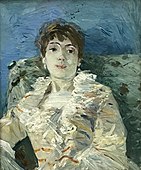
Daughter on Divan (ca. 1885)
-
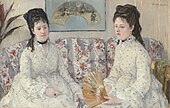
-
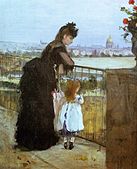
On the Balustrade (Femme et enfant au balcon), 1872, New York City
-

-

Jour d'été Summer's Day, 1879, National Gallery, London Alternative title: French: Le Lac du bois de Boulogne The Lake in the Bois de Boulogne
-
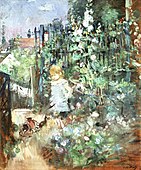
Kid among the Hollyhocks (Kind zwischen Stockrosen) (Enfant dans les roses trémières), 1881, Wallraf-Richartz Museum
-

Before the Mirror (1890)
-

Le Flageolet (The Flute Player) 1890
Portraits of Morisot [edit]
-

Berthe Morisot on a divan couch, 1872, by Édouard Manet
-

Portrait of Berthe Morisot, 1882, By Édouard Manet
-
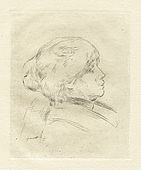
Berthe Morisot, 1892, by Renoir
Art market [edit]

Morisot's work sold comparatively well. She achieved the two highest prices at a Hôtel Drouot auction in 1875, the Interior (Young Woman with Mirror) sold for 480 francs, and her pastel On the Backyard sold for 320 francs.[126] [127] Her works averaged 250 francs, the best relative prices at the auction.[128]
In February 2013, Morisot became the highest priced female artist, when After Lunch (1881), a portrait of a immature redhead in a straw hat and majestic dress, sold for $10.nine 1000000 at a Christie's auction. The painting achieved roughly iii times its upper estimate,[129] [130] [131] exceeding the $10.vii million for a sculpture by Louise Bourgeois in 2012.[129]
Legacy [edit]
She was portrayed past actress Marine Delterme in a 2012 French biographical TV moving picture directed by Caroline Champetier. The character of Beatrice de Clerval in Elizabeth Kostova's The Swan Thieves is largely based on Morisot.[132]
She was featured as the "A First Impressionist" in an article written by Anne Truitt in the New York Times on June 3, 1990.[133]
From Melissa Burdick Harmon, an editor at Biography magazine, "While some of Morisot's work may seem to us today similar sweet depictions of babies in cradles, at the time these images were considered extremely intimate, as objects related to infants belonged exclusively to the globe of women."[eight]
In 2019, the Musée d'Orsay devoted a temporary exhibition to Berthe Morisot to pay tribute to her work.
Exhibition [edit]
| Selected Berthe Morisot Solo Exhibitions | Date |
| Paris, Boussod, Valadon et Cie. Exposition de tableaux, pastels et dessins par Berthe Morisot. | 1892, May 25 – June eighteen |
| Paris, Galerie Durand-Ruel. Berthe Morisot (Madame Eugene Manet): exposition de son œuvre. | 1896, March 5–23 |
| Paris: Galerie Durand-Ruel. Exposition Berthe Morisot. | 1902, April 23 – May 10 |
| Paris, Galerie E. Druet. Exposition Berthe Morisot. | 1905, January–February |
| Paris, Galerie Manzi-Joyant. Exposition Berthe Morisot. | 1912 |
| Paris. Galerie Manzi-Joyant. Exposition Berthe Morisot. | 1914, Apr |
| Paris, Galerie Bernheim-Jeune. Cent oeuvres de Berthe Morisot (1841–1895). | 1919, November 7–22 |
| Paris, Galerie Marcel Bernheim. Réunion d'oeuvres, par Berthe Morisot. | 1922, June 20 – July 8 |
| Chicago, Arts Club of Chicago. Exposition of Paintings by Berthe Morisot. three p. | 1925, January thirty – March 10 |
| London, Ernest Brown & Phillips, The Leicester Galleries. Berthe Morisot Exhibition | 1930, March–Apr |
| New York, Wildenstein Galleries. Berthe Morisot Exhibition. | 1936, November 24 – December 12 |
| Paris, Musée de 50'Orangerie. Berthe Morisot, 1841–1895. | 1941, Summer |
| Paris, Galerie Weil. Berthe Morisot, retrospective. | 1947 |
| Copenhagen, NY Carlsberg Glyptotek. Berthe Morisot, 1841–1895: Mälningar: Olja och Akvarellsamt Teckningar. | 1949, Baronial 20 – October 23 |
| Boston, Museum of Fine Arts, Boston. Berthe Morisot: Drawings, Pastels, Watercolors. | 1960, Oct ten – December 10 |
| Paris, Musée Jacquemart-Andre, lnstitut de French republic. Berthe Morisot. | 1961 |
| Paris, Galerie Hopkins-Thomas. Berthe Morisot. | 1987–88, Apr – May 9 |
| London, JPL Fine Arts. Berthe Morisot (1841–1895). | 1990–91, November 7 – Jan xviii |
| Paris, Galerie Hopkins Thomas. Berthe Morisot. | 1993, October 15 – November 30 |
| Lille, the Palais des Beaux-Arts, Berthe Morisot | 2002, March x – June ix |
| Washington DC, National Museum of Women in the Arts, Berthe Morisot: An Impressionist and Her Circle | 2005, Jan 14 – May 8 |
| Spain, Madrid, Museo Thyssen-Bornemisza, Berthe Morisot: The Woman impressionist | 2012, November xv – February 12 |
| Québec, The Musée National des Beaux-arts du Québec, Berthe Morisot: Woman Impressionist | 2018, June 21 – September 23 |
Run into also [edit]
- Women artists
- Western painting
- History of painting
- Julie Manet
Notes [edit]
- ^ The scene L'Entrée du port is often confused with L'Entrée du port de Cherbourg purchased in 1874 by Durand-Ruel, or dislocated with Le Port de Cherbourg
References [edit]
- ^ Denvir, 2000, pp. 29–79.
- ^ Solomon, Tessa (July 27, 2020). "The Women of Impressionism: Berthe Morisot, Mary Cassatt, and Other Pioneering Figures Who Shaped the Movement". ARTnews.com . Retrieved July 29, 2020.
- ^ Smith, Hazel (Jan 7, 2019). "Berthe Morisot and Édouard Manet: Painters in Paris". France Today . Retrieved October iv, 2021.
- ^ Geffroy, Gustave (1894), "Histoire de l'Impressionnisme", Le Vie Artistique: 268 .
- ^ "Berthe Morisot | Biography, Art, Paintings, & Facts". Encyclopedia Britannica . Retrieved July 9, 2021.
- ^ a b Adler, Kathleen (1987). Berthe Morisot. Ithaca, New York: Cornell Academy Press. pp. 9. ISBN0801420539.
- ^ Higonnet, p. 5
- ^ a b c d Harmon, Melissa Burdick. "Monet, Renoir, Degas...Morisot the Forgotten Genius of Impressionism." Biography, vol. v, no. 6, June 2001, p. 98. EBSCOhost
- ^ a b Higonnet, Anne (1990). Berthe Morisot. New York: Harper & Row, Publishers. pp. xi–25. ISBN0-06-016232-5.
- ^ a b "Yves peinte par Degas".
- ^ a b Stuckey et al, p. 16 harvnb error: no target: CITEREFStuckey_et_al (aid)
- ^ "Women in the Human activity of Painting, 9 November 2012, Edma and Berthe by Nancy Bea Miller".
- ^ "Berthe Morisot by Anne Higonnet, Berthe Morisot, at Google Books. Page 32".
- ^ Garb, T. (2003). "Morisot, Berthe(-Marie-Pauline)". Grove Art Online.
- ^ Berthe Morisot : 1841–1895. Mathieu, Marianne., Musée Marmottan. Paris. 2012. ISBN9780300182019. OCLC 830199379.
{{cite book}}: CS1 maint: others (link) - ^ Berthe Morisot : 1841–1895. Mathieu, Marianne., Musée Marmottan. Paris. 2012. ISBN9780300182019. OCLC 830199379.
{{cite book}}: CS1 maint: others (link) - ^ Berthe Morisot : 1841–1895. Mathieu, Marianne., Musée Marmottan. Paris. 2012. ISBN9780300182019. OCLC 830199379.
{{cite volume}}: CS1 maint: others (link) - ^ Berthe Morisot : 1841–1895. Mathieu, Marianne., Musée Marmottan. Paris. 2012. ISBN9780300182019. OCLC 830199379.
{{cite book}}: CS1 maint: others (link) - ^ Berthe Morisot : 1841–1895. Mathieu, Marianne., Musée Marmottan. Paris. 2012. ISBN9780300182019. OCLC 830199379.
{{cite book}}: CS1 maint: others (link) - ^ a b c d e f Dominique., Rey, Jean (2010). Berthe Morisot. Patry, Sylvie., Morisot, Berthe, 1841–1895., Lalaurie, Louise Rogers. Paris: Flammarion. ISBN9782080301680. OCLC 646401344.
- ^ National Museum of Women in the Arts: "The Cage". Retrieved November 24, 2014.
- ^ Mongan, Elizabeth (1960). Berthe Morisot, Drawings Pastels, Watercolors. New York: Shorewood Publishing Co. p. 20.
- ^ a b c Stuckey, Charles F.; Scott, William P. (1987). Berthe Morisot: Impressionist. New York: Hudson Hills Press. pp. 187–207. ISBN0-933920-03-2.
- ^ Berthe Morisot : 1841–1895. Mathieu, Marianne., Musée Marmottan. Paris. 2012. ISBN9780300182019. OCLC 830199379.
{{cite book}}: CS1 maint: others (link) - ^ Berthe Morisot : 1841–1895. Mathieu, Marianne., Musée Marmottan. Paris. 2012. ISBN9780300182019. OCLC 830199379.
{{cite book}}: CS1 maint: others (link) - ^ Higonnet, Anne (1990). Berthe Morisot. New York: Harper & Row, Publishers, Inc. p. 26. ISBN0-06-016232-5.
- ^ Higonnet, Anne (1990). Berthe Morisot. New York: Harper & Row, Publishers, Inc. p. 102. ISBN0-06-016232-5.
- ^ Chadwick, Whitney (2012). Women, Art, and Society (Fifth ed.). London: Thames & Hudson Inc. p. 253. ISBN978-0-500-20405-4.
- ^ Lewis, 1000.T. "Book Reviews: Berthe Morisot." Art Journal, vol. 50, no. 3, Fall91, p. 92. EBSCOhost,
- ^ Chadwick, Whitney (2012). Women, Fine art, and Order (5th ed.). London: Thames & Hudson Ltd. p. 234. ISBN978-0-500-20405-iv.
- ^ Higonnet, Anne (1990). Berthe Morisot. New York: Harper & Row, Publishers, Inc. p. 139. ISBN0-06-016232-five.
- ^ Higonnet, Anne (1990). Berthe Morisot. New York: Harper & Row, Publishers, Inc. p. 158. ISBN0-06-016232-5.
- ^ "Berthe Morisot | French painter". Encyclopædia Britannica . Retrieved March 29, 2018.
- ^ Valentinovna), Brodskai︠a︡, Northward. 5. (Natalʹi︠a︡. Impressionism. New York. ISBN9781780428017. OCLC 778448857.
- ^ Commire, Anne, ed. (2001). Women in World History: A Biographical Encyclopedia. Vol. 11. Waterford: Yorkin Publications, Gale Group. p. 448. ISBN978-0-78764-070-five.
- ^ Stuckey, Scott Lindsay, p. 23 harvnb error: no target: CITEREFStuckey,_Scott_Lindsay (help)
- ^ Stuckey, Scott Lindsay, p. 24 harvnb error: no target: CITEREFStuckey,_Scott_Lindsay (help)
- ^ Bataille Wildenstein, p. 11 harvnb mistake: no target: CITEREFBataille_Wildenstein (help)
- ^ Bataille Wildenstein, p. 12 harvnb error: no target: CITEREFBataille_Wildenstein (assistance)
- ^ Stuckey, Scott Lindsay, p. 34 harvnb error: no target: CITEREFStuckey,_Scott_Lindsay (help)
- ^ Stuckey, Scott Lindsay, p. 35 harvnb error: no target: CITEREFStuckey,_Scott_Lindsay (assistance)
- ^ Stuckey, Scott Lindsay, p. 40 harvnb error: no target: CITEREFStuckey,_Scott_Lindsay (aid)
- ^ Stuckey, Scott Lindsay, p. 41 harvnb error: no target: CITEREFStuckey,_Scott_Lindsay (help)
- ^ Stuckey, Scott Lindsay, p. 45 harvnb error: no target: CITEREFStuckey,_Scott_Lindsay (aid)
- ^ Stuckey, Scott Lindsay, p. 46 harvnb mistake: no target: CITEREFStuckey,_Scott_Lindsay (assistance)
- ^ Stuckey, Scott Lindsay, p. 47 harvnb mistake: no target: CITEREFStuckey,_Scott_Lindsay (assist)
- ^ "Berthe Morisot, Femme et enfant au balcon (On the Balcony), 1871–72, Art Found of Chicago".
- ^ Bataille Wildenstein, p. 260 harvnb error: no target: CITEREFBataille_Wildenstein (help)
- ^ Bataille Wildenstein, p. 419 harvnb mistake: no target: CITEREFBataille_Wildenstein (help)
- ^ "Madame Pontillon, descriptif actuel".
- ^ Bataille Wildenstein, p. 42 harvnb fault: no target: CITEREFBataille_Wildenstein (help)
- ^ Stuckey, Scott Lindsay, p. 53 harvnb error: no target: CITEREFStuckey,_Scott_Lindsay (assistance)
- ^ Stuckey, Scott Lindsay, p. 51 harvnb mistake: no target: CITEREFStuckey,_Scott_Lindsay (help)
- ^ a b Stuckey, Scott Lindsay, p. 56 harvnb error: no target: CITEREFStuckey,_Scott_Lindsay (help)
- ^ Bataille Wildenstein, p. 28 harvnb fault: no target: CITEREFBataille_Wildenstein (help)
- ^ Bataille Wildenstein, p. 34 harvnb error: no target: CITEREFBataille_Wildenstein (assistance)
- ^ Stuckey, Scott Lindsay, p. 61 harvnb fault: no target: CITEREFStuckey,_Scott_Lindsay (help)
- ^ a b Stuckey, Scott Lindsay, p. 63 harvnb error: no target: CITEREFStuckey,_Scott_Lindsay (assist)
- ^ Bataille Wildenstein, p. 427 harvnb error: no target: CITEREFBataille_Wildenstein (help)
- ^ Stuckey, Scott Lindsay, p. 64 harvnb mistake: no target: CITEREFStuckey,_Scott_Lindsay (aid)
- ^ Stuckey, Scott Lindsay, p. 65 harvnb error: no target: CITEREFStuckey,_Scott_Lindsay (assist)
- ^ Bataille Wildenstein, p. 61 harvnb error: no target: CITEREFBataille_Wildenstein (help)
- ^ Bataille Wildenstein, p. 52 harvnb error: no target: CITEREFBataille_Wildenstein (assistance)
- ^ Stuckey, Scott Lindsay, p. 69 harvnb fault: no target: CITEREFStuckey,_Scott_Lindsay (help)
- ^ Bataille Wildenstein, p. 51 harvnb error: no target: CITEREFBataille_Wildenstein (help)
- ^ a b Stuckey, Scott Lindsay, p. 71 harvnb error: no target: CITEREFStuckey,_Scott_Lindsay (help)
- ^ Bataille Wildenstein, p. 73 harvnb fault: no target: CITEREFBataille_Wildenstein (help)
- ^ Bataille Wildenstein, p. 81 harvnb error: no target: CITEREFBataille_Wildenstein (help)
- ^ "Jeune Femme arrosant un arbuste (Primary Championship) - (83.40)". Virginia Museum of Fine Arts | . Retrieved January 9, 2020.
- ^ Bataille Wildenstein, p. 59 harvnb error: no target: CITEREFBataille_Wildenstein (help)
- ^ Bataille Wildenstein, p. 64 harvnb error: no target: CITEREFBataille_Wildenstein (help)
- ^ Bataille Wildenstein, p. 434 harvnb error: no target: CITEREFBataille_Wildenstein (help)
- ^ Bataille Wildenstein, p. 75 harvnb error: no target: CITEREFBataille_Wildenstein (help)
- ^ Bataille Wildenstein, p. 78 harvnb error: no target: CITEREFBataille_Wildenstein (aid)
- ^ Stuckey, Scott Lindsay, p. 81 harvnb error: no target: CITEREFStuckey,_Scott_Lindsay (help)
- ^ Stuckey, Scott Lindsay, p. 82 harvnb error: no target: CITEREFStuckey,_Scott_Lindsay (assist)
- ^ Stuckey, Scott Lindsay, p. 83 harvnb mistake: no target: CITEREFStuckey,_Scott_Lindsay (help)
- ^ Robert Rosenblum, Paintings in the Musée D'Orsay, p. 305, Stewart, Tabori & Chang (1989).
- ^ Stuckey, Scott Lindsay, p. 85 harvnb error: no target: CITEREFStuckey,_Scott_Lindsay (help)
- ^ Stuckey, Scott Lindsay, p. 91 harvnb mistake: no target: CITEREFStuckey,_Scott_Lindsay (help)
- ^ a b Bataille Wildenstein, p. 112 harvnb error: no target: CITEREFBataille_Wildenstein (help)
- ^ Bataille Wildenstein, p. 113 harvnb error: no target: CITEREFBataille_Wildenstein (assist)
- ^ Stuckey, Scott Lindsay, p. 95 harvnb mistake: no target: CITEREFStuckey,_Scott_Lindsay (help)
- ^ Bataille Wildenstein, p. 138 harvnb error: no target: CITEREFBataille_Wildenstein (help)
- ^ "voir La Fable". Archived from the original on December 5, 2014. Retrieved November 26, 2014.
- ^ Stuckey, Scott Lindsay, p. 96 harvnb mistake: no target: CITEREFStuckey,_Scott_Lindsay (help)
- ^ Stuckey, Scott Lindsay, p. 97 harvnb error: no target: CITEREFStuckey,_Scott_Lindsay (help)
- ^ Bataille Wildenstein, p. 154 harvnb error: no target: CITEREFBataille_Wildenstein (help)
- ^ Stuckey, Scott Lindsay, p. 101 harvnb error: no target: CITEREFStuckey,_Scott_Lindsay (assistance)
- ^ Stuckey, Scott Lindsay, p. 98 harvnb mistake: no target: CITEREFStuckey,_Scott_Lindsay (help)
- ^ Stuckey, Scott Lindsay, p. 103 harvnb error: no target: CITEREFStuckey,_Scott_Lindsay (assistance)
- ^ "aperçu de la toile Meule de foin".
- ^ Stuckey, Scott Lindsay, p. 104 harvnb error: no target: CITEREFStuckey,_Scott_Lindsay (help)
- ^ Stuckey, Scott Lindsay, p. 105 harvnb error: no target: CITEREFStuckey,_Scott_Lindsay (help)
- ^ Stuckey, Scott Lindsay, p. 107 harvnb fault: no target: CITEREFStuckey,_Scott_Lindsay (assistance)
- ^ Stuckey, Scott Lindsay, p. 109 harvnb error: no target: CITEREFStuckey,_Scott_Lindsay (aid)
- ^ "Minneapolis Institute of Fine art".
- ^ "The Artist'southward Girl, Julie, with her Nanny, Berthe Morisot ^ Minneapolis Institute of Fine art". collections.artsmia.org . Retrieved February 17, 2018.
- ^ Stuckey, Scott Lindsay, p. 110 harvnb error: no target: CITEREFStuckey,_Scott_Lindsay (assist)
- ^ Stuckey, Scott Lindsay, p. 111 harvnb error: no target: CITEREFStuckey,_Scott_Lindsay (help)
- ^ Stuckey, Scott Lindsay, p. 115 harvnb error: no target: CITEREFStuckey,_Scott_Lindsay (help)
- ^ Stuckey, Scott Lindsay, p. 117 harvnb mistake: no target: CITEREFStuckey,_Scott_Lindsay (help)
- ^ Stuckey, Scott Lindsay, p. 120 harvnb error: no target: CITEREFStuckey,_Scott_Lindsay (help)
- ^ Stuckey, Scott Lindsay, p. 122 harvnb error: no target: CITEREFStuckey,_Scott_Lindsay (help)
- ^ Stuckey, Scott Lindsay, p. 121 harvnb error: no target: CITEREFStuckey,_Scott_Lindsay (help)
- ^ Bataille Wildenstein, p. 197 harvnb error: no target: CITEREFBataille_Wildenstein (help)
- ^ Stuckey, Scott Lindsay, p. 127 harvnb error: no target: CITEREFStuckey,_Scott_Lindsay (help)
- ^ Stuckey, Scott Lindsay, p. 128 harvnb error: no target: CITEREFStuckey,_Scott_Lindsay (assist)
- ^ Stuckey, Scott Lindsay, p. 129 harvnb error: no target: CITEREFStuckey,_Scott_Lindsay (help)
- ^ Bataille Wildenstein, p. 750 harvnb error: no target: CITEREFBataille_Wildenstein (help)
- ^ Stuckey, Scott Lindsay, p. 131 harvnb fault: no target: CITEREFStuckey,_Scott_Lindsay (help)
- ^ Stuckey, Scott Lindsay, p. 133 harvnb error: no target: CITEREFStuckey,_Scott_Lindsay (aid)
- ^ Stuckey, Scott Lindsay, p. 134 harvnb error: no target: CITEREFStuckey,_Scott_Lindsay (assist)
- ^ "Berthe Morisot and Julie Manet, Berthe Morisot ^ Minneapolis Found of Art". collections.artsmia.org . Retrieved February 17, 2018.
- ^ Bataille Wildenstein, p. 542 harvnb error: no target: CITEREFBataille_Wildenstein (help)
- ^ Stuckey, Scott Lindsay, p. 142 harvnb error: no target: CITEREFStuckey,_Scott_Lindsay (help)
- ^ Stuckey, Scott Lindsay, p. 147 harvnb fault: no target: CITEREFStuckey,_Scott_Lindsay (help)
- ^ Stuckey, Scott Lindsay, p. 152 harvnb error: no target: CITEREFStuckey,_Scott_Lindsay (help)
- ^ Bataille Wildenstein, p. 275 harvnb mistake: no target: CITEREFBataille_Wildenstein (help)
- ^ Stuckey, Scott Lindsay, p. 155 harvnb error: no target: CITEREFStuckey,_Scott_Lindsay (help)
- ^ Stuckey, Scott Lindsay, p. 165 harvnb error: no target: CITEREFStuckey,_Scott_Lindsay (assistance)
- ^ Stuckey, Scott Lindsay, p. 172 harvnb error: no target: CITEREFStuckey,_Scott_Lindsay (aid)
- ^ Stuckey, Scott Lindsay, p. 173 harvnb mistake: no target: CITEREFStuckey,_Scott_Lindsay (help)
- ^ Stuckey, Scott Lindsay, p. 174 harvnb mistake: no target: CITEREFStuckey,_Scott_Lindsay (help)
- ^ Morisot, Berthe. "Adult female at Her Toilette". The Art Constitute of Chicago . Retrieved May 24, 2021.
- ^ Chadwick, Whitney (2012). Women, Fine art, and Society (fifth ed.). London: Thames & Hudson Ltd. p. 235. ISBN978-0-500-20405-iv.
- ^ Higonnet, Anne (1990). Berthe Morisot. New York: Harper & Row, Publishers, Inc. p. 124. ISBN0-06-016232-5.
- ^ Shennan, Margaret (1996). Berthe Morisot: The First Lady of Impressionism. Stroud: Sutton Publishing Limited. p. 173. ISBN0-7509-1226 X.
- ^ a b Kelly Crow and Mary Grand. Lane (Feb 6, 2013), Christie's Breaks World Record Price for Female Artist The Wall Street Journal.
- ^ Ellen Gamerman and Mary G. Lane (Apr 18, 2013), Women on the Verge The Wall Street Journal.
- ^ Katya Kazakina (May 14, 2014), Billionaires Help Christie'southward to Record $745 One thousand thousand Sale Bloomberg.
- ^ Trisha, Managing Editor (November 17, 2009). "Sneak peek: Elizabeth Kostova's 'The Swan Thieves'". bookpage.com. Retrieved March 17, 2012.
- ^ Truitt, Anne. "A FIRST IMPRESSIONIST". Retrieved March 29, 2018.
Sources [edit]
- Denvir, B. (2000). The Chronicle of Impressionism: An Intimate Diary of the Lives and Earth of the Neat Artists. London: Thames & Hudson. OCLC 43339405
- Higonnet, Anne (1995). Berthe Morisot. Berkeley: University of California Press. ISBN 0-520-20156-half-dozen
- Turner, J. (2000). From Monet to Cézanne: late 19th-century French artists. Grove Art. New York: St Martin'southward Press. ISBN 0-312-22971-2
- Manet, Julie, Rosalind de Boland Roberts, and Jane Roberts. Growing Upwards with the Impressionists: The Diary of Julie Manet. London: Sotheby's Publications, 1987
- Shennan, Margaret (1996). Berthe Morisot: The Offset Lady of Impressionism. Stroud: Sutton Publishing. ISBN 0-7509-2339-3
External links [edit]
| External video | |
|---|---|
| | |
| |
Source: https://en.wikipedia.org/wiki/Berthe_Morisot
0 Response to "Where Is Berthe Morisot Display Where Is Berthe Morisot Display of Art"
Post a Comment